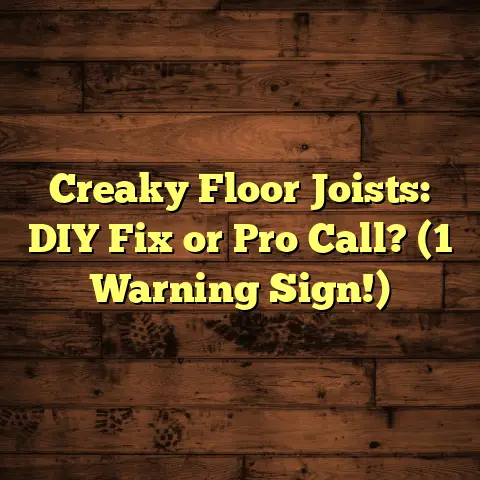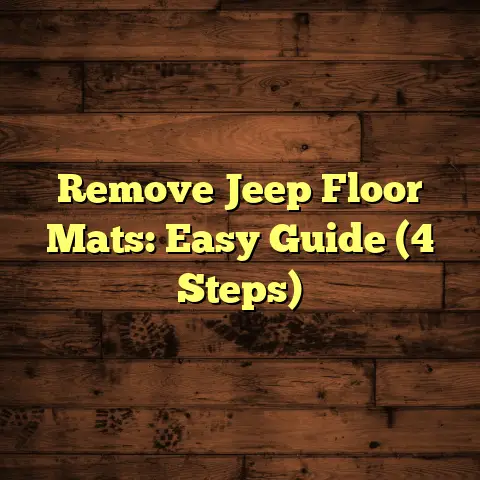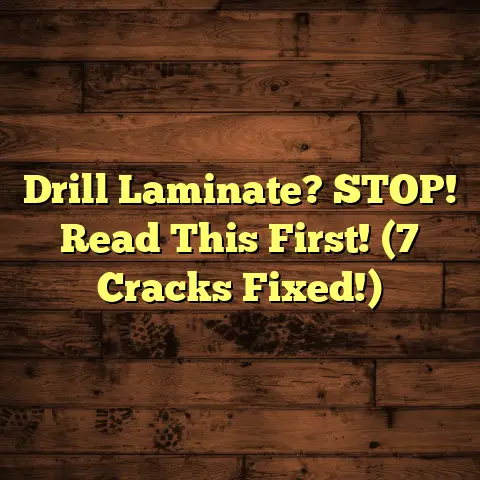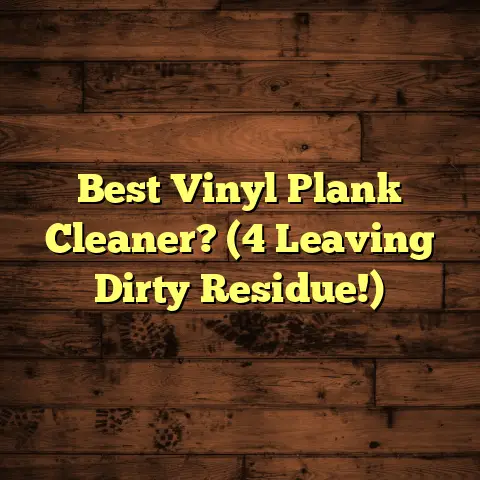Cleaning Porcelain Floors: The Key (1 Trick!)
The Key (1 Trick!)
I’m a flooring contractor, and I’ve spent years knee-deep in dust, grout, and the occasional spilled cup of coffee.
One thing I’ve learned is that porcelain floors are fantastic.
They’re super popular in homes and businesses because they’re tough, don’t mind getting wet, and look great.
Plus, everyone thinks they’re easy to clean, which is a big reason why people choose them, especially if they have kids or pets.
But let’s be real, keeping them pristine can sometimes feel like a never-ending battle, right?
That’s why I’m excited to share a game-changing trick that’ll simplify your cleaning routine and keep your porcelain floors looking their absolute best.
Get ready to say goodbye to endless scrubbing and hello to sparkling floors with minimal effort!
Chapter 1: Understanding
Porcelain Floors
So, what exactly are porcelain tiles?
Basically, they’re a type of ceramic tile made from a refined clay mixture fired at super high temperatures.
This process makes them incredibly dense and durable, which is why they’re so resistant to water, stains, and scratches.
Think of it like this: regular ceramic is like a good, solid biscuit, while porcelain is like that biscuit after it’s been compressed by a hydraulic press.
Tougher, right?
Finishes Matter
Now, porcelain tiles come in all sorts of finishes, and these finishes definitely impact how you should clean them.
You’ve got:
-
Glazed: These have a glass-like coating that makes them super resistant to stains and easy to wipe clean.
-
Matte: Matte finishes are less slippery and hide dirt better, but they can sometimes be a bit more porous and require a little more elbow grease.
-
Textured: These mimic the look of natural stone or wood and can have grooves and ridges that trap dirt.
-
Polished: Polished porcelain tiles have a glossy, mirror-like finish that looks amazing but can show smudges and scratches more easily.
The type of finish dictates the kind of cleaner you use and how often you need to clean.
Glazed vs. Unglazed
Another key distinction is between glazed and unglazed porcelain.
Glazed tiles have that protective coating I mentioned earlier, while unglazed tiles are more porous and vulnerable to staining.
Glazed porcelain is the low- maintenance superstar.
It’s like having a Teflon pan for your floor – most spills wipe right up!
Unglazed porcelain, on the other hand, requires a bit more care.
You’ll need to seal it periodically to protect it from stains and dirt.
Think of it like waxing your car – it adds a layer of protection and keeps it looking shiny.
Busting Myths
Let’s clear up some common misconceptions about porcelain floor maintenance:
-
Myth #1: Porcelain is indestructible. While it’s super durable, it’s not invincible. Harsh chemicals and abrasive cleaners can still damage the surface.
-
Myth #2: You don’t need to clean porcelain often. Even though it’s stain-resistant, dirt and grime can still build up over time, making your floors look dull.
-
Myth #3: All cleaners are safe for porcelain. Nope! Acidic cleaners like vinegar can actually etch the surface of some porcelain tiles, especially those with a polished finish.
Understanding the nuances of porcelain is the first step towards keeping your floors looking fantastic.
Chapter 2: Why Regular Cleaning
is Essential
Okay, so we know porcelain is tough and beautiful, but why is regular cleaning so important?
Well, think of your floors as a reflection of your home.
Clean floors instantly make a space feel brighter, more inviting, and, let’s be honest, just plain better.
But beyond aesthetics, regular cleaning is crucial for:
-
Prolonging the Life of Your Floors: Dirt, grit, and grime act like sandpaper, slowly wearing down the surface of your tiles over time. Regular cleaning removes these abrasive particles, preventing scratches and dullness.
-
Maintaining Their Beauty: Even the most beautiful porcelain tiles can look dingy if they’re covered in a layer of dirt. Regular cleaning restores their shine and brings out their natural colors.
-
Preventing Stains: While porcelain is stain-resistant, it’s not stain-proof. Spills, especially those from acidic or oily substances, can penetrate the surface if left untreated for too long.
-
Improving Air Quality: Floors can trap dust, allergens, and other pollutants that can affect your indoor air quality. Regular cleaning removes these particles, creating a healthier living environment.
The Consequences of Neglect
What happens if you neglect your porcelain floors?
Well, you might start to notice:
-
Stubborn Stains: Spills that were once easy to wipe up become permanent fixtures.
-
Dullness: Your once-shiny floors lose their luster and start to look lifeless.
-
Scratches: Those tiny scratches from dirt and grit become more visible, especially in high-traffic areas.
-
Grout Discoloration: The grout between your tiles becomes stained and discolored, making your entire floor look dirty.
-
Costly Repairs: In severe cases, neglect can lead to cracked or chipped tiles, requiring expensive repairs or even replacement.
The Numbers Don’t Lie
According to the National Wood Flooring Association (NWFA), regular cleaning and maintenance can extend the life of your floors by up to 50%.
That’s a huge saving in the long run!
Think about it: replacing a floor can easily cost thousands of dollars, while a little bit of regular cleaning can save you a fortune.
Plus, a well-maintained floor can increase the value of your home.
It’s a win-win situation!
Chapter 3: Common Cleaning Methods
and Their Limitations
Alright, let’s talk about the usual suspects when it comes to cleaning porcelain floors.
You’ve probably tried some of these methods yourself:
-
Mopping: The classic method. You fill a bucket with water and cleaner, dunk in a mop, and get to work.
-
Vacuuming: Great for removing loose dirt and debris before mopping.
-
Steam Cleaning: Uses hot steam to loosen dirt and grime without the need for harsh chemicals.
Mopping: The Good, the Bad,
and the Wet Mopping is a staple for a reason.
It’s effective at removing surface dirt and grime, and it’s relatively inexpensive.
But it also has its drawbacks:
Pros:
- Effective at removing surface dirt.
- Relatively inexpensive.
- Easy to do.
Cons:
- Can leave streaks if you don’t wring out the mop properly.
- Can spread dirty water around if you don’t change the water frequently.
- Can damage grout if you use harsh cleaners.
Vacuuming: A Necessary Evil?
Vacuuming is essential for removing loose dirt and debris before mopping.
It prevents you from just pushing the dirt around with a wet mop.
Pros:
- Effective at removing loose dirt and debris.
- Prevents scratches from abrasive particles.
- Can be used on all types of porcelain floors.
Cons:
- Doesn’t remove stuck-on grime.
- Can be time-consuming if you have a large area to cover.
- Some vacuums can scratch delicate finishes.
Steam Cleaning: Hot and Bothered?
Steam cleaning is a chemical-free option that uses hot steam to loosen dirt and grime.
It’s great for killing bacteria and sanitizing your floors.
Pros:
- Chemical-free cleaning.
- Sanitizes floors.
- Effective at loosening stuck-on grime.
Cons:
- Can be expensive to purchase a steam cleaner.
- Can damage some types of grout.
- May not be effective on heavily soiled floors.
The Struggle is Real
So, why do so many homeowners struggle with these methods?
Well, here’s the thing:
-
They can be time-consuming. Mopping a large floor can take forever, especially if you have to keep changing the water.
-
They can be ineffective. Sometimes, no matter how much you scrub, you just can’t seem to get your floors clean.
-
They can be frustrating. Streaks, smudges, and dirty grout can make you want to throw in the towel.
-
They can be risky. Using the wrong cleaners or techniques can damage your floors.
I’ve seen it all: etched porcelain from vinegar, scratched surfaces from abrasive cleaners, and grout that’s permanently stained from harsh chemicals.
It’s enough to make you want to give up and just live with dirty floors!
But don’t despair, because I’m about to share a trick that will change your cleaning routine forever.
Chapter 4: Introducing the Key Trick
for Cleaning Porcelain Floors
Okay, drumroll please…
The one key trick for cleaning porcelain floors is:
Using a microfiber mop with a pH-neutral cleaner!
I know, it sounds simple, right?
But trust me, this combination is a game-changer.
Let’s break it down:
Microfiber Magic
Microfiber mops are made from tiny, split fibers that are incredibly effective at trapping dirt, dust, and grime.
They’re like tiny magnets for dirt!
Unlike traditional cotton mops, microfiber mops don’t just push the dirt around; they actually lift it off the floor.
Plus, they’re super absorbent, so they don’t leave your floors soaking wet.
pH-Neutral Power
pH-neutral cleaners are gentle on porcelain and won’t damage the surface or grout.
They’re also safe for use around pets and children.
Avoid acidic cleaners like vinegar or lemon juice, as they can etch the surface of some porcelain tiles.
Also, steer clear of alkaline cleaners like bleach, as they can discolor grout.
Step-by-Step Instructions
Here’s how to implement the trick:
-
Vacuum or sweep your floors: Remove any loose dirt and debris before you start mopping.
-
Fill a bucket with warm water and a pH-neutral cleaner: Follow the manufacturer’s instructions for the correct dilution ratio.
-
Dampen your microfiber mop: Wring out the mop thoroughly so it’s not dripping wet.
-
Mop your floors in overlapping strokes: Work in small sections and rinse the mop frequently.
-
Rinse with clean water (optional): If you want to remove any cleaner residue, you can rinse your floors with clean water after mopping.
-
Let your floors air dry: Or, you can use a clean, dry microfiber cloth to speed up the drying process.
Why This Trick Works
This method simplifies the cleaning process in several ways:
-
It’s faster: Microfiber mops cover more surface area than traditional mops, so you can clean your floors in less time.
-
It’s more effective: Microfiber mops trap more dirt and grime than traditional mops, so your floors will be cleaner.
-
It’s safer: pH-neutral cleaners are gentle on porcelain and won’t damage the surface or grout.
-
It’s easier: You don’t have to scrub as hard to get your floors clean.
Real-Life Results
I’ve seen this trick transform cleaning routines for countless homeowners.
Here’s a testimonial from one of my clients:
“I used to dread cleaning my porcelain floors. It was always such a hassle, and I could never seem to get them really clean. Now, I can clean my floors in half the time, and they look better than ever.” – Sarah M.
Chapter 5: The Science Behind
the Trick
Okay, so we know the trick works, but why does it work?
Let’s dive into the science behind it:
Microfiber: The Dirt Magnet
Microfiber is made from synthetic fibers, usually a blend of polyester and polyamide.
These fibers are split into thousands of tiny strands, creating a huge surface area.
This large surface area allows microfiber to trap more dirt, dust, and grime than traditional cotton fibers.
Think of it like Velcro: the tiny hooks and loops grab onto dirt and hold it tight.
pH-Neutral Cleaners: The Gentle Giants
pH is a measure of how acidic or alkaline a substance is.
The pH scale ranges from 0 to 14, with 7 being neutral.
Acidic substances have a pH below 7, while alkaline substances have a pH above 7.
Porcelain is generally resistant to acids and alkalis, but prolonged exposure to extreme pH levels can damage the surface.
That’s why pH-neutral cleaners are the best choice for porcelain floors.
They’re gentle enough not to damage the surface, but still effective at removing dirt and grime.
Addressing Common Issues
This trick addresses some of the most common issues faced by porcelain floor owners:
-
Stubborn Stains: The combination of microfiber and pH-neutral cleaner is effective at removing most stains, especially when treated promptly.
-
Grime Buildup: Microfiber’s superior cleaning power prevents grime from building up on your floors.
-
Dullness: Regular cleaning with this method restores your floors’ shine and prevents them from looking dull.
Research and Studies
While there aren’t specific studies on this exact cleaning method for porcelain floors, there’s plenty of research on the effectiveness of microfiber and pH-neutral cleaners.
For example, a study published in the Journal of Applied Microbiology found that microfiber cloths were more effective at removing bacteria from surfaces than traditional cotton cloths.
And the EPA recommends using pH-neutral cleaners for general cleaning to protect surfaces and the environment.
Chapter 6: Maintenance Beyond
Cleaning
Okay, so you’ve mastered the key trick, but what else can you do to keep your porcelain floors looking their best?
Here are some additional maintenance tips:
-
Regular Sealing (If Applicable): If you have unglazed porcelain tiles, you’ll need to seal them periodically to protect them from stains.
-
Using Mats and Rugs: Place mats at entrances to trap dirt and debris before they get tracked onto your floors.
-
Sweeping Regularly: Sweep your floors regularly to remove loose dirt and debris.
-
Cleaning Up Spills Promptly: The sooner you clean up a spill, the less likely it is to stain your floors.
-
Avoiding Abrasive Cleaners: Never use abrasive cleaners or scouring pads on your porcelain floors, as they can scratch the surface.
Creating a Cleaning Schedule
To keep your porcelain floors looking their best, create a cleaning schedule that works for you.
Here’s a sample schedule:
-
Daily: Sweep or vacuum high-traffic areas.
-
Weekly: Mop your floors using the microfiber mop and pH-neutral cleaner trick.
-
Monthly: Deep clean your grout with a grout brush and a grout cleaner.
-
Annually: Reseal unglazed porcelain tiles.
Conclusion
So, there you have it: the one key trick for cleaning porcelain floors!
By using a microfiber mop with a pH-neutral cleaner, you can simplify your cleaning routine, reduce time spent, and enhance results.
Remember, maintaining your porcelain flooring doesn’t have to be a daunting task.
With a little bit of knowledge and the right tools, you can keep your floors looking their best for years to come.
So, go ahead and try the trick.
Experience the transformative impact on your cleaning routine, leading to a cleaner and more inviting home environment.
Happy cleaning!





